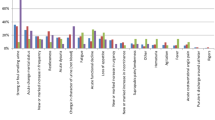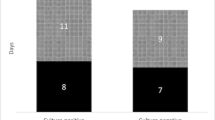Abstract
Urinary tract infection (UTI) is an important health problem affecting millions of people each year. A significant high incidence of UTI can be seen in individuals with disabilities, especially those with paralysis due to spinal cord injury. Dip stick screening tests may offer promise as an early warning system of UTI since they are easy to perform and can be self-administered. Here, we report our experience of the diagnostic value of the urine strip test for white blood cell count in medical laboratory practice. The sensitivity of urine strip test was 100%, the specificity 92.2%, the positive predictive value 33.8% and the negative predictive value 100%. False positive was 7.8% and false negative 0%. This can confirm the needs for further examination in cases with positive urine strip screening test. Hence, the usage of urine strip examination as a screening tool for pyuria, an early sign of UTI among people with disabilities is recommended.
Similar content being viewed by others
References
Waites, K.B., Canupp, K.C., DeVivo, M.J.: Epidemiology and risk factors for urinary tract infection following spinal cord injury. Arch. Phys. Med. Rehabil. 74, 691–695 (1993)
Girard, R., Mazoyer, M.A., Plauchu, M.M., Rode, G.: High prevalence of nosocomial infections in rehabilitation units accounted for by urinary tract infections in patients with spinal cord injury. J. Hosp. Infect. 62, 473–479 (2006)
The prevention and management of urinary tract infections among people with spinal cord injuries. National Institute on Disability and Rehabilitation Research Consensus Statement. January 27–29, 1992. J. Am. Paraplegia Soc. 15, 194–204 (1992)
The prevention and management of urinary tract infections among people with spinal cord injuries. National Institute on Disability and Rehabilitation Research Consensus Statement. January 27–29, 1992. SCI Nursing 10, 49–61 (1993)
Garcia Leoni, M.E., Esclarin De Ruz, A.: Management of urinary tract infection in patients with spinal cord injuries. Clin. Microbiol. Infect. 9, 780–785 (2003)
Werner, H., Kuntsche, J.: Infection in the elderly—what is different? Z. Gerontol. Geriatr. 33, 350–356 (2000)
Washington, J.A., Henry, J.B.: Medical microbiology. In: Henry, J.B. (ed.) Clinical Diagnosis and Management, 17th edn. Saunders, Philadelphia (1984)
Ram K.R.: Health challenges of 21st century and traditional medicine in SAARC Region. Available online at http://www.ayurnepal.com/articles/rishi_saarc.htm.
Parry, E., Parry, V.: Training for health care in developing countries: the work of the Tropical Health and Education Trust. Med. Edu. 32, 630–635 (1998)
Choudhury, J.K.: Technology and status of health care delivery in third world with special reference to India. IEEE Eng. Med. Biol. 7, 2869–2870 (1992)
Bronzino, J.D., Gover, J.: Medical technology: a solution to the health care cost problem. IEEE Eng. Med. Biol. 9, 313–315 (1994)
Kunin, C.M.: Urinary tract infections: detection, prevention, and management, 5th edn. Williams & Wilkins, Baltimore (1997)
Krieger, J.N.: Urinary tract infections: what’s new? J. Urol. 168, 2351 (2002)
Hooton, T.M.: Pathogenesis of urinary tract infections: an update. J. Antimicrob. Chemother. 46(Suppl 1), 1 (2000)
Hummers-Pradier, E., Kochen, M.M.: Urinary tract infections in adult general practice patients. Br. J. Gen. Pract. 52, 752 (2000)
Cardenas, D.D., Hooton, T.M.: Urinary tract infection in persons with spinal cord injury. Arch. Phys. Med. Rehabil. 76, 272–280 (1995)
Herruzo Cabrera, R., Leturia Arrazola, A., Vizcaino Alcaide, M.J., Fernandez Arjona, M., Rey Calero, J.: Analytic epidemiology of clinical urinary tract infection in spinal cord injury. Eur. J. Epidemiol. 10, 23–27 (1994)
Biering-Sorensen, F., Bagi, P., Hoiby, N.: Urinary tract infections in patients with spinal cord lesions: treatment and prevention. Drugs 61, 1275–1287 (2001)
Tuel, S.M., Meythaler, J.M., Cross, L.L., McLaughlin, S.: Cost-effective screening by nursing staff for urinary tract infection in the spinal cord injured patient. Am. J. Phys. Med. Rehabil. 69, 128–131 (1990)
Sharief, N., Hameed, M., Petts, D.: Use of rapid dipstick tests to exclude urinary tract infection in children. Br. J. Biomed. Sci. 55, 242–246 (1998)
Cardenas, D.D., Hoffman, J.M., Kelly, E., Mayo, M.E.: Impact of a urinary tract infection educational program in persons with spinal cord injury. J. Spinal Cord Med. 27, 47–54 (2004)
Acknowledgements
The authors would like to thank all medical personnel of the Department of Laboratory Medicine, Faculty of Medicine, Chulalongkorn University who performed all tests in this report.
Author information
Authors and Affiliations
Corresponding author
Rights and permissions
About this article
Cite this article
Wiwanitkit, V., Ekawong, P. Diagnostic Value of Urine Strip Testing for White Blood Cells: an Implication for Screening in Individuals with Spinal Cord Injury. Sex Disabil 25, 197–201 (2007). https://doi.org/10.1007/s11195-007-9056-6
Published:
Issue Date:
DOI: https://doi.org/10.1007/s11195-007-9056-6




